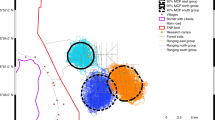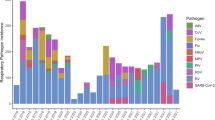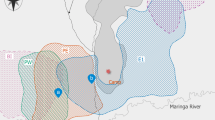Abstract
A flu-like disease spread among chimpanzees (Pan troglodytes schweinfurthii) of the M group at Mahale Mountains National Park, Tanzania, from June to July 2006. This epizootic or epidemic killed up to 12 chimpanzees. The obvious evidence of their deaths came from finding the bodies of three infants who had previously shown some symptoms of the disease. At least one of these infants died of pneumonia. In addition, nine chimpanzees were missing after the outbreak. These individuals were assumed to have been killed by this epizootic because most of them had contact with the infected individuals on the last days they were observed. We also found two dead bodies during this period, which were thought to be those of two missing individuals. We confirmed 23 (35.4%) of 65 individuals of the M group showed some symptoms of the disease, although most of them (20/23) did not die. More than half of them (14/23) had kin showing symptoms. Since this epizootic may have been caused by contact with humans, it will be necessary to establish and follow appropriate protocols for researchers, tourists, and park staff to observe chimpanzees, and to explore the mechanism of disease transmission from humans to chimpanzees and among chimpanzees.
Similar content being viewed by others
Avoid common mistakes on your manuscript.
Introduction
Previous studies have reported the deaths of many chimpanzees killed by infectious diseases such as flu-like epizootics, poliomyelitis, and Ebola hemorrhagic fever in their natural habitats (Goodall 1986; Boesch and Boesch-Achermann 2000; Matsuzawa et al. 2004; Reynolds 2005; Lonsdorf et al. 2006). Among chimpanzees of the M group at Mahale Mountains National Park, Tanzania, 48% of all deaths have been caused by disease (Nishida et al. 2003). In 1986, an epizootic termed “AIDS-like disease” by research assistants killed several chimpanzees of the M group (Nishida 1990), and in 1993, a flu-like epizootic killed at least 11 chimpanzees (Hosaka 1995). From June to July 2006, a flu-like disease again broke out among this unit group (or community) and likely killed 12 individuals. Here, we report symptoms of this disease, it’s transmission among kin, the estimated number of dead individuals, and corpses found.
Methods
The subjects of the study were chimpanzees (Pan troglodytes schweinfurthii) of the M group at the Mahale Mountains National Park, Tanzania, which have been studied since 1965 (Nishida 1990). Here, kin was defined as mother and offspring, and sibling relationships.
Between March and September 2006, SH, MK, MF, MN, and two research assistants made focal or ad libitum observations to record the attendance, health conditions, general activities, and ranging routes of individuals. During the period of the outbreak, SH and MK recorded the symptoms and behavior of sick individuals. ML and TM performed postmortem examinations of two chimpanzees.
Results
General symptoms and the number of sick individuals
A few of the M group chimpanzees occasionally show some symptoms of diseases, which, however, usually do not spread among many chimpanzees (Nishida et al. unpublished data). We observed five chimpanzees coughing in March, only one individual sneezing in April and none showing symptoms of disease in May 2006. The first chimpanzee showing symptom of the epizootic reported here was an adult male DW, who was observed coughing on 3 June 2006. Within several days, an adult female AK and adult males, AL (alpha) and BB (beta), also began to cough. As M group chimpanzees were dispersing over a wide area during this period, some individuals were not observed and consequently their conditions were unknown. Nevertheless, the number of individuals who showed symptoms of disease continued to increase steadily (Fig. 1). Between June and July, at least 23 individuals (35.4% of the entire M group, which numbered 65 before the outbreak) showed some symptoms of disease such as coughing, sniveling, and crouching on the ground. In the latter half of July, the number of individuals showing symptoms decreased. The disease almost disappeared by the end of July and finally 20 of 23 individuals recovered. Among 23 individuals who showed symptoms, 14 (60.9%) had kin who also showed symptoms, 5 (21.7%) had kin without showing symptoms, and 4 (17.4%) did not have any kin.
Daily number of individuals and the total number of individuals that showed symptom(s) of disease (coughing, sniveling, and/or crouching on the ground). Solid bar Total number of observed individuals with symptoms during each 5 day period from March to September 2006, Open bar Total number of observed individuals without symptoms from March to September 2006, Line Accumulated number of individuals that showed symptoms at least once from May to August 2006. Because the number of observers and the degree of dispersion of chimpanzees differed daily, the observation conditions were not equal. Moreover, the proportion of the number of individuals with symptoms to those without symptoms may have been overestimated when we focused our observations on seriously weakened individuals (from 18 June to 15 July)
Three observed deaths of infants and survival of their matrilineal kin
On 18 June, a female infant RH and her older sister RC were observed with flu-like symptoms including coughing, sniveling and clear nasal discharge. On 19 June, their mother RB also began to show symptoms. All three gradually worsened; they often crouched listlessly on the ground and could hardly travel or eat. On 23 June, we only found RB and RC, but not RH. On 26 June, we found RH’s corpse. The symptoms observed in RH’s mother (RB) and older sister (RC) progressively diminished. A postmortem examination was conducted on RH on 27 June, and RH was diagnosed as having died of acute pneumonia.
Another female infant XT05 and her mother XT were first seen coughing on 21 June. On 22 June, XT05 began to experience rhinorrhea, and XT often lay down on the ground. We found XT carrying the dead body of XT05 on 1 July. After 3 July, XT no longer showed any disease symptoms and seemed to have recovered. XT’s other offspring, XM (adolescent male) and XP (juvenile female), were also seen coughing in early July, but they recovered.
On 13 July, we observed the other female infant WX05 coughing and sniveling, and her mother WX coughing. On 14 July, they could scarcely move and did not leave the bed until noon. On the next day, we found WX carrying her dead infant. WX continued to cough until 17 July. WX’s other offspring, AT (adolescent female) did not show any symptoms of the disease, and AL (adult male) did but recovered.
Inferred deaths
In addition to the above three confirmed deaths, we assumed that up to nine other chimpanzees died of this disease (Table 1). Those nine did not show any symptoms on the days they were last seen, but they have not been seen at the time of this writing (31 May 2007), 10 months later. Although temporal absence does not necessarily imply the deaths of chimpanzees, we rarely met individuals who had been absent for more than 10 months besides young females transferring between unit groups or ostracized adult males (unpublished attendance record). Moreover, because most individuals of the M group usually travel together from September to January (Itoh and Nishida 2007), absence during the entire September–January period strongly suggests that these individuals died. This inference is also supported by the observations that two juvenile daughters of missing adult females PI and MJ, were continuously observed with others (implying that their mothers died), and that two mothers of missing infants LD06 and CY06, resumed estrus (confirming real absence of the infants). In addition, most missing individuals were confirmed or assumed to have had contact with infected individuals when they were last seen (Table 1). Therefore, we assumed that their deaths were caused by the disease. The exception is the death of the adult male MA, whose death cannot be ascribed to the epizootic, because he was not seen since before the epizootic began (Table 1).
Dead bodies found
We found an adult female corpse on 29 June. We assumed that this was a member of the M group since the body was found where the M group had occasionally ranged in June. A postmortem examination was performed on 30 June. The state of the molar and premolar teeth made it possible to approximate the age between 20 and 30 years. The shape of the remaining parts of the inguinal area, together with the size of the teeth and body were those of a female rather than a male. Based on the expected date of the death (around 20–22 June), this individual was likely a missing adult female MJ or OP (see Table 1). On 3 July, we found the upper part of a cranium and a left scapula, which were completely ossified. Other bones were not found although we carefully searched the area. Based on their sizes, we estimated that these bones had come from a juvenile. Because OS was the only missing juvenile (Table 1), the bones likely belonged to OS.
Discussion
Some authors (Nishida 1990; Hosaka 1995) have assumed that deaths were caused by diseases when individuals showed symptoms of illness on the last days they were observed. If we follow this example, we would estimate that only three individuals had died of this epizootic. However, as we also found two additional dead bodies, this assumption may lead to an underestimation of deaths caused by the disease. The epizootic may have killed eight other individuals given their confirmed or likely contact with infected individuals. The missing adult male MA, who was observed regularly before this outbreak, but who disappeared before the first animal with symptoms was seen, may also have been a victim without researchers noticing. Therefore, this flu-like epizootic apparently killed a maximum of 12 chimpanzees. This number is very similar to the number of deaths (11 individuals) caused by another flu-like epizootic among the M group in 1993 (Hosaka 1995).
How did this flu-like disease break out? The outbreak seemed to begin with an infection of an adult male. Adult males may be particularly likely to initiate spread of a disease because they tend to travel with many individuals (Nishida 1990). Additionally, transmission between kin was evident. Our observation of three mothers RB, XT and WX, and their offspring, together with the fact that more than 60% of symptomatic individuals had kin who also showed symptoms, suggests that the disease was easily shared among kin. Since adult females and their dependent offspring almost always traveled together (Nishida 1990), if a member of such family becomes infected, the disease would easily spread to his/her family. One exception was the case of AT, WX’s independent adolescent daughter, who did not show symptoms.
It should also be noted that, among the families of RB, XT and WX showing disease symptoms, only infants died. It is possible that infants are endangered by not only their own illness, but also their mothers. For instance, infant WX05 fell out of a tree twice because of her mother’s weakness.
It is suggested that spatial proximity and time spent together between individuals may be the key factors of disease transmission among them. In other words, some matrilineal families, ostracized males, transferring young females and male-female pairs showing “consortship”, who are assumed to have little contact with other individuals depending on the circumstances, might experience lower risk of infection. For example, an adult female AB and her two dependent offspring were never observed during June and appeared alone at the eastern edge of the M group’s range on 8 July showing no symptoms of the disease.
The death of numerous chimpanzees caused by epizootic has occurred not only in Mahale but also in other areas (see "Introduction"). Although the etiology and route(s) of transmission were not confirmed, it is possible that some of these epizootics were caused by increased contact with humans. Thus, it is necessary to explore appropriate ways for both researchers and tourists to observe chimpanzees (cf., Wallis and Lee 1999; Woodford et al. 2002). Following the epizootic described here, we requested that all people who observe the M group wear face masks whenever they observe the chimpanzees (Hanamura et al. 2006). This will at least reduce the risk of droplet infection from humans. Like this attempt, researchers, tour operators, and park staff must cooperate to establish and follow appropriate protocols for observing the animals, in order to minimize the risk of epizootic outbreaks among unit groups of habituated chimpanzees. Furthermore, we need to identify the etiology and route(s) of any disease transmission from humans to chimpanzees. For that purpose, we have collected samples of chimpanzees showing symptoms of disease and are establishing health monitoring system in close cooperation with veterinarians.
References
Boesch C, Boesch-Achermann H (2000) The chimpanzees of the Taï forest: behavioural ecology and evolution. Oxford University Press, Oxford
Goodall J (1986) The chimpanzees of Gombe: patterns of behavior. Harvard University Press, Cambridge
Hanamura S, Kiyono M, Nakamura M, Sakamaki T, Itoh N, Zamma K, Kitopeni R, Matumla M, Nishida T (2006) A new code of observation employed at Mahale: prevention against a flu-like disease. Pan Afr News 13:13–16
Hosaka K (1995) A single flu epidemic killed at least 11 chimps. Pan Afr News 2(2):3–4
Itoh N, Nishida T (2007) Chimpanzee grouping patterns and food availability in Mahale Mountains National Park, Tanzania. Primates 48:87–96
Lonsdorf EV, Travis D, Pusey AE, Goodall J (2006) Using retrospective health data from the Gombe chimpanzee study to inform future monitoring efforts. Am J Primatol 68:897–908
Matsuzawa T, Humle T, Koops K, Biro D, Hayashi M, Sousa C, Mizuno Y, Kato A, Yamakoshi G, Ohashi G, Sugiyama Y, Kourouma M (2004) Wild chimpanzees at Bossou-Nimba: deaths through a flu-like epidemic in 2003 and the Green-Corridor Project. Primate Res 20:45–55
Nishida T (ed) (1990) The chimpanzees of the Mahale Mountains. University of Tokyo Press, Tokyo
Nishida T, Corp N, Hamai M, Hasegawa T, Hiraiwa-Hasegawa M, Hosaka K, Hunt KD, Itoh N, Kawanaka K, Matsumoto-Oda A, Mitani JC, Nakamura M, Norikoshi K, Sakamaki T, Turner L, Uehara S, Zamma K (2003) Demography, female life history, and reproductive profiles among the chimpanzees of Mahale. Am J Primatol 59:99–121
Reynolds V (2005) The chimpanzees of the Budongo forest: ecology, behaviour, and conservation. Oxford University Press, Oxford
Wallis J, Lee DR (1999) Primate conservation: the prevention of disease transmission. Int J Primatol 20:803–826
Woodford MH, Butynski TM, Karesh WB (2002) Habituating the great apes: the disease risks. Oryx 36:153–160
Acknowledgments
We thank COSTECH, TAWIRI, TANAPA and Mahale Mountains National Park for permission to conduct research; R. Kitopeni and M. Matumula for assisting in the research; A. H. Harcourt and K. N. Cameron for useful comments; and H. Y. Kayumbo, T. Nemoto, and A. Inaba for encouragement. This study was financed by MEXT Grants-in-Aid for Scientific Research (#16255007 to TN and #16770186 to MN) and a Global Environment Research Fund (F-061 to TN) from the Ministry of Environment.
Author information
Authors and Affiliations
Corresponding author
About this article
Cite this article
Hanamura, S., Kiyono, M., Lukasik-Braum, M. et al. Chimpanzee deaths at Mahale caused by a flu-like disease. Primates 49, 77–80 (2008). https://doi.org/10.1007/s10329-007-0054-1
Received:
Accepted:
Published:
Issue Date:
DOI: https://doi.org/10.1007/s10329-007-0054-1





